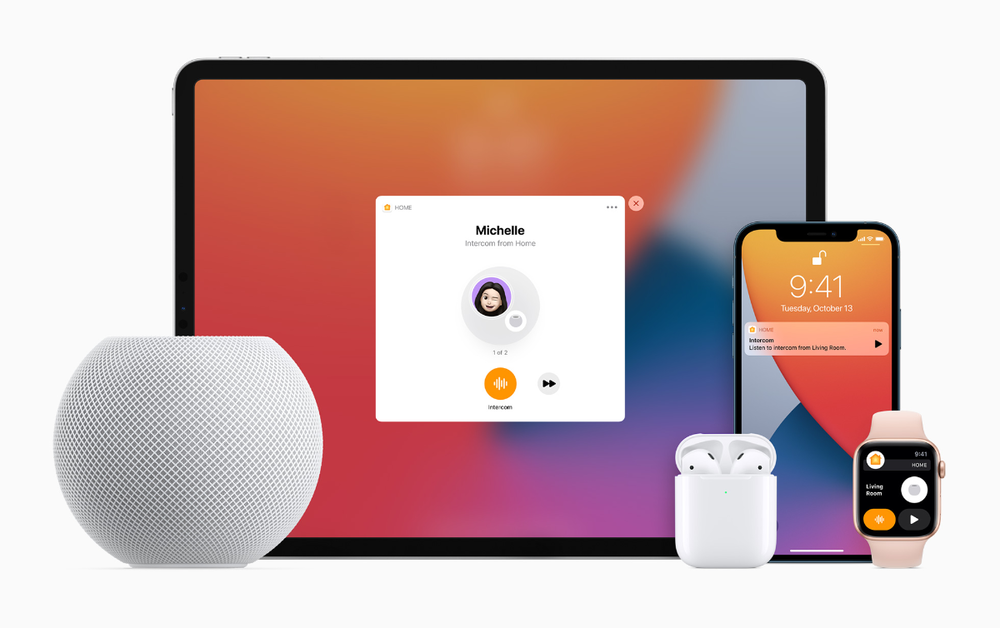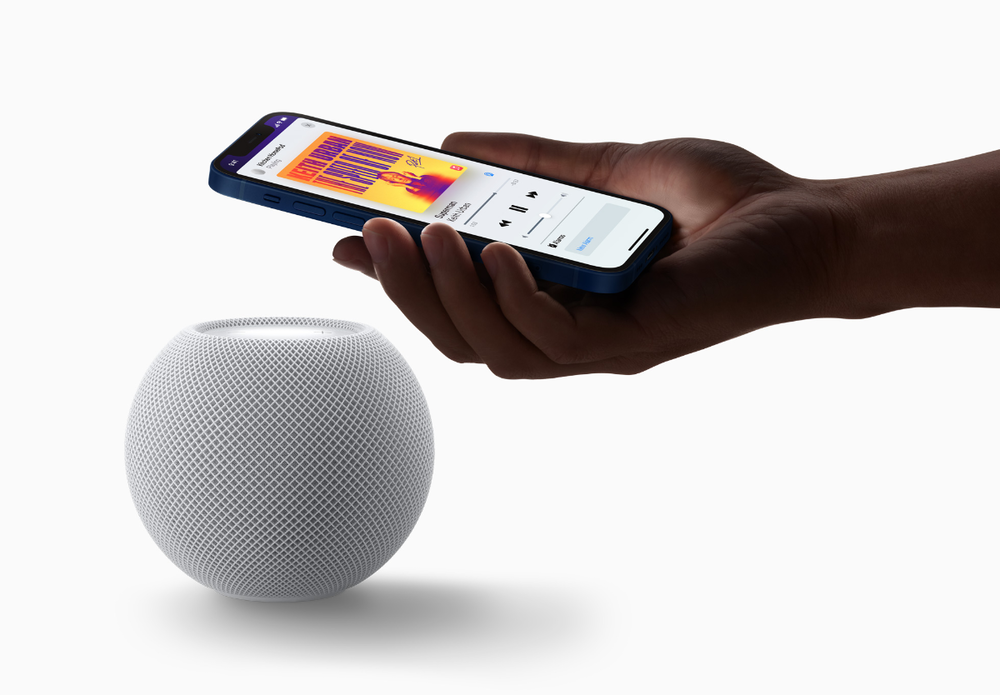As expected, Apple today unveiled the HomePod mini, the newest addition to the HomePod family of wireless speakers. And the price is US$99, about half the price some pundits predicted. You can order pre-order it on Friday, Nov. 6, and it will ship on Nov. 13.
The HomePod mini is 3.3 inches tall and, like its big brother, will be available in white and space gray. It works with the iPhone to hand off music, answer calls, or deliver personalized listening suggestions, elevates the sound from Apple TV, plays music from a Mac, and more, according to Bob Borchers, Apple’s vice president of Worldwide Product Marketing.

The HomePod mini is designed to work with Apple Music, podcasts, radio stations from iHeartRadio, radio.com, and TuneIn, and in the coming months, popular music services including Pandora and Amazon Music. Multiple HomePod mini speakers work together to stream music or podcasts to multiple rooms, all in perfect sync, Borchers says. By placing two HomePod mini speakers in a single room, a stereo pair can be created for a wide soundstage, filling the space with rich, enveloping sound.
The tiny speaker uses computational audio to deliver peak performance. Borchers says that to achieve big sound out of such a compact design, the Apple S5 chip in the HomePod mini works with advanced software to analyze the unique characteristics of the music and apply complex tuning models to optimize loudness, adjust the dynamic range, and control the movement of the driver and passive radiators in real time. The Apple-engineered full-range driver, powered by a neodymium magnet and a pair of force-cancelling passive radiators, enables deep bass and crisp high frequencies, he adds.
The HomePod mini features an Apple-designed acoustic waveguide to direct the flow of sound down and out toward the bottom of the speaker for a 360-degree audio experience. This allows customers to place a HomePod mini almost anywhere in a room and hear consistent sound. A three-microphone array listens for “Hey Siri,” and a fourth inward-facing microphone helps isolate sound coming from the speaker to improve voice detection when music is playing.
Siri can identify who is speaking and tailor music and podcasts to his/her preferences, and respond to personal requests, like accessing messages, reminders, notes, and calendar appointments, or making and answering phone calls. Siri also offers users a personal update for a quick snapshot of their day. With a single request, users can ask Siri “What’s my update?” to hear the latest news, weather, traffic, reminders, and calendar appointments.

When listening to music on an iPhone, users can bring their device close to the HomePod mini and “hand off” the music without missing a beat. Borchers says that, later this year, the experience gets even better with visual, audible, and haptic effects when sound transfers from one device to the other. Personalized listening suggestions will also automatically appear on an iPhone when it is next to HomePod mini, and instant controls are available without having to unlock iPhone.
The speaker is designed to make controlling smart home accessories easier than ever with simple voice commands for Siri to turn off the lights, change the temperature, lock the doors, or set a scene.
A new Intercom feature offers a quick way for family members to connect with each other at home. One person can send an Intercom message from one HomePod to another — whether in a different room, a specific zone, or multiple rooms throughout the home — and their voice will automatically play on the designated HomePod speaker. Intercom works with iPhone, iPad, Apple Watch, AirPods, and CarPlay.
With the HomePod mini, only after “Hey Siri” is recognized locally on the device, or the user activates Siri by touch, will any information be sent to Apple servers, according to the tech giant. Requests are not associated with the user’s Apple ID, and personal information is not sold to advertisers or other organizations. HomePod mini works with iPhone to complete requests for messages and notes on device without revealing that information to Apple.
Additional features include:
-
Siri Shortcuts created on iPhone and iPad are accessible on HomePod mini, so users can ask Siri on HomePod mini to start a pot of coffee, control a robot vacuum, add milk to the grocery list, and more.
-
Ambient sounds, including rain, a fireplace, a stream, and more, offer the perfect background noise to focus, relax, or fall asleep. Siri can set a sleep timer so the sounds automatically stop playing.
-
Find My helps locate a misplaced iPhone, iPad, iPod touch, Mac, or Apple Watch by playing a sound to pinpoint its location.
-
Web search results from HomePod mini can be sent directly to the user’s iPhone for easy viewing.
-
Music alarms let users wake up to a favorite song, playlist, or radio station from Apple Music.
Lisa Jackson, Apple’s vice president of Environment, Policy and Social Initiatives, says the HomePod mini was designed with the environment in mind and supports Apple’s plan to have net zero climate impact across its entire business, which includes manufacturing supply chains and all product life cycles, by 2030. The speaker utilizes 99% recycled rare earth elements, with the neodymium magnet in the speaker driver utilizing 100% recycled rare earth elements, she adds. The seamless mesh fabric is made with more than 90% recycled plastic, and all of the packaging wood fibers are from responsibly managed forests or recycled sources. HomePod mini is also free of mercury, brominated flame retardants, PVC, and beryllium, according to Jackson.
The HomePod mini uses power-efficient components and software that can intelligently power them down during periods of inactivity. For example, through optimized power management features and a high-efficiency power supply, HomePod mini has been designed to be efficient in its low-power mode, where the majority of time is spent. The result is that HomePod mini is energy efficient right out of the box. HomePod mini consumes 75% less energy than the stringent requirements for ENERGY STAR, according to Jackson.
